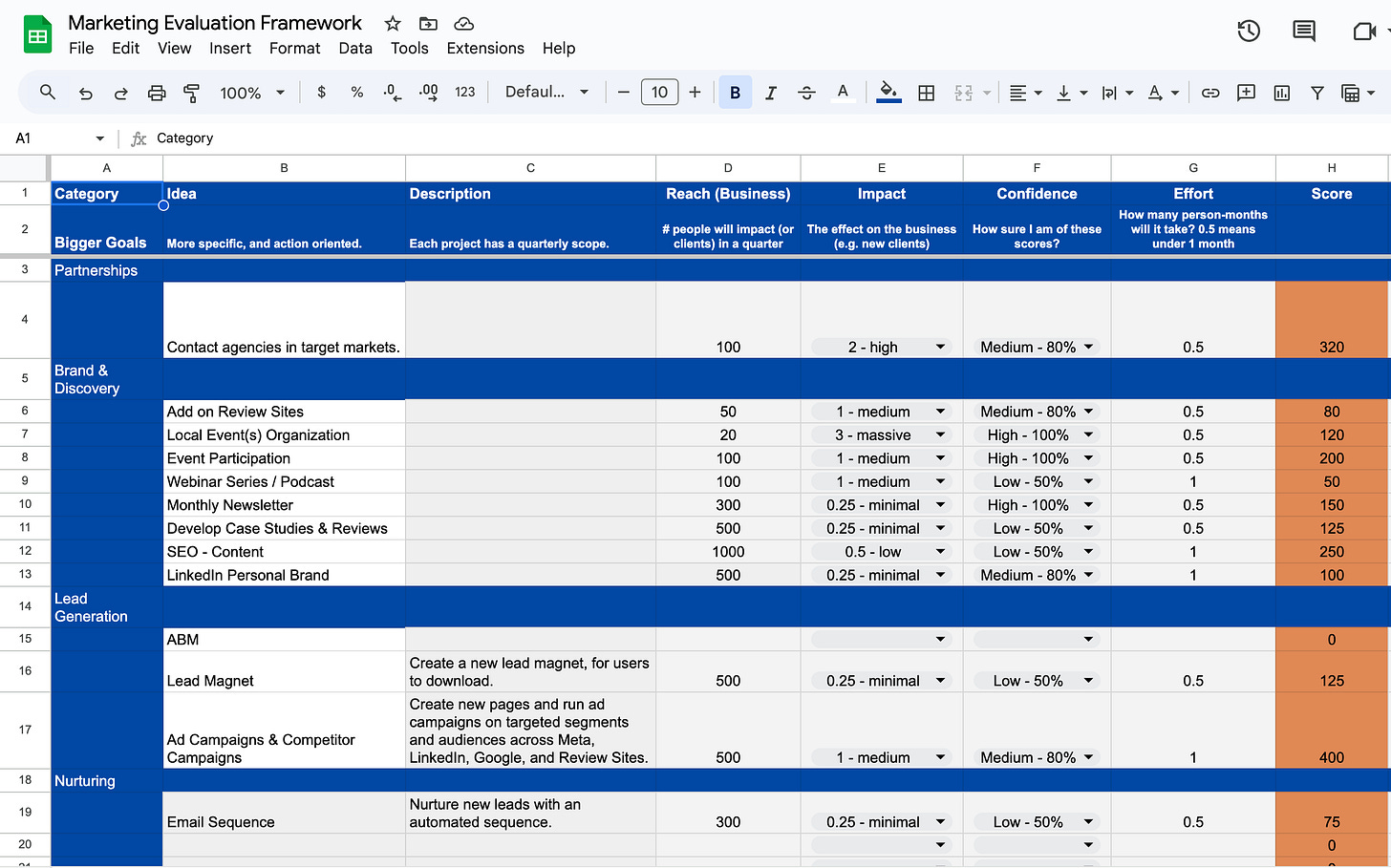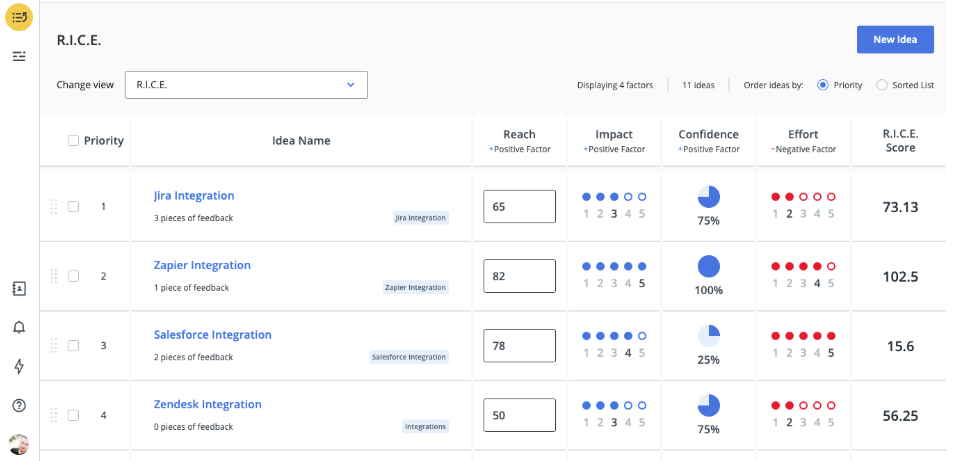How to prioritize Marketing Actions with the RICE Framework + Template
Your marketing ideas backlog is bursting, your team is buzzing, and everyone’s got “the next big idea.” But not all ideas deserve to star in your next marketing sprint.
Enter RICE; the framework that turns chaos into a clear, confident roadmap for growth.
🔑Key takeaways from this week's newsletter:
RICE helps you pick the right ideas.
How to identify the easy wins first.
How to use RICE for marketing prioritization.
The maths behind the methodology.
Famous brands that used RICE to scale.
Let's break this down.
This September, I will be at Digital Olympus Event in Amsterdam.
Join me on the 11th of September, for a VIP experience in marketing, with top speakers representing some of the biggest brands in marketing-led roles.
*This is not a sponsored ad. If you are going to be there, ping me on LinkedIn and we can meet on the day of the event!
Meet RICE
R.I.C.E. is a primarily product management tool to prioritize ideas over the product backlog. The same methodology can be used to prioritize marketing projects or actions, although with a few changes on how to approach it.
Why use R.I.C.E.?
If you’ve build a high-productivity, high-creativity team, your product backlog is probably bursting. Ideas everywhere, features you’d love to ship are coming in on a daily basis.
But which ones actually deserve the spotlight to your next sprint?
And which ones should stay parked at the bottom of your backlog for just a bit longer?
Meet RICE; RICE lets you score ideas clearly based on Reach, Impact, Confidence, and Effort, so you can focus on what truly drives growth.
How does RICE work?
RICE cuts through the chaos of “too many ideas, not enough time.” It scores each backlog item on Reach, Impact, Confidence, and Effort, turning gut feelings into hard numbers.
Source: Roadmunk.com
Big reach and impact with low effort? That’s your winner. Weak confidence and high effort? Park it for later. It’s the shortcut from endless debates to a roadmap your team actually believes in.
Using RICE as a Marketing Evaluation Framework
Most marketing brainstorming ending up generating dozens of ideas, and your team might even end up collecting 100+ marketing projects or actions.
This can easily lead to indecision or decision-fatigue, due to the sheer number of ideas.
Using a framework like RICE to evaluate these ideas, helps prioritize them with the most impactful ones first.
Important Notes
The RICE score might not always be the best way to decide, take it as an indicator. With industry expertise, you usually get a “gut feeling” of what works best for your industry.
Leave some space for your gut feelings, and consider adding some long-shot ideas into the mix that you truly believe they will resonate with your audience.
When using RICE, I usually see some ideas I am excited about score low, and helps me surface invisible opportunities that I may have skipped without taking a hard look at the numbers.
Usually, I will pick 4-5 ideas to prioritize for the quarter based on the RICE score, but also add 1-2 with low or medium scores that I truly believe will resonate with the audience I try to reach.
9 Cases you should let RICE “decide”
When your idea backlog is packed and you need clarity.
When teams compete for resources and opinions clash.
When planning your marketing roadmap for max impact.
When prioritizing growth experiments or marketing campaigns.
When time or budget is tight and mistakes are costly.
When you need data‑backed decisions instead of gut calls.
When presenting priorities to leadership or investors.
When revisiting old ideas to see if they’re worth it.
When optimizing for ROI and speed, not just output.
The maths behind RICE methodology
RICE takes the guesswork out of prioritization with one simple formula. It tells you which ideas actually move the needle versus which ones just sound exciting in a meeting.
Not every shiny idea pays the bills. RICE gives you the “ammo” to prove which product backlog items actually matter. So when the board asks “why this, not that,” you’ve got the receipts handy.
Source: www.savio.io
Reach, Impact, and Confidence push your score up. The more people you touch, the bigger the effect, and the surer you are, the better.
Effort drags the score down because hard, resource‑heavy tasks need a bigger payoff to be worth it.
How to use each variable
Reach: Consider this an absolute number based on your KPIs, you can consider to use audience reach, leads, or customers this activity can generate.
Impact: This is about converting the people into the next step of the funnel or into revenue, you can consider for example whether the conversion from a lead to a paid customer will be high, or if the customers this activity will generate come with high ACV/ARR.
Confidence: How confident you are on your data for this activity? Did you base one number on hard internal stats, or more on gut feelings? The confidence will downgrade an idea with uncertain results and help you prioritize ideas with hard data behind it.
Effort: Every activity requires human effort, and in most teams this is a scarce resource. Effort helps you add the Human Resources into the equation. Whether it will take a few hours, days, or months of implementation.
How to use RICE
How to use RICE as a marketer
As a marketer, RICE is your filter against “shiny‑object syndrome”. Score every campaign or experiment by Reach, Impact, Confidence, and Effort. High score? Launch it. Low score? Park it. RICE keeps your energy on moves that actually drive growth.
How to use RICE as product owner
As a product owner, RICE helps you make clear, objective choices. Score each backlog item by its Reach, Impact, Confidence, and Effort, then compare the results. High scores guide your next moves, while low scores can safely wait their turn.
How to use RICE as SaaS founder
Especially in the MVP stage, when resources are tight, every decision carries extra weight and can make the difference between moving fast or burning time on the wrong thing. Prioritize feature development and roadmap decisions by quantifying which ideas will drive the most adoption or retention for the least effort.
Dos & Don'ts in RICE framework
✅ Do’s
Score everything first, debate later. Let the numbers cut through the noise.
Revisit scores regularly. Data changes, and so should your priorities.
Use RICE as a guide, not gospel. Combine numbers with real‑world context.
Focus on high‑impact, low‑effort wins. That’s where growth lives.
❌ Don’ts
Inflate Reach or Impact. Optimism bias kills objectivity.
Ignore Effort. Huge projects with small upside are silent killers.
Rely only on gut feelings. RICE works because it adds clarity to instinct.
Treat scores as final. Priorities shift; flexibility keeps you sharp.
Big brands winning with RICE
📌Airbnb
Airbnb didn’t scale by chasing shiny ideas; they scaled by scoring them. In its hyper‑growth phase, Airbnb leaned on RICE to decide what to ship first: smoother guest bookings, faster host onboarding, smarter platform updates. Today, RICE is still how their product team makes every call. And I think they are right doing so!
📌Intercom
Intercom was the one that put RICE on the map. Their product and growth teams have scored everything from onboarding tweaks to messaging upgrades and new integrations. The result? Fewer debates, faster decisions, and a roadmap everyone actually buys into.
📌HubSpot
HubSpot has built its own lead‑scoring approach (probably inspired by RICE and similar frameworks). It’s not the first time HubSpot adopts proven business tools, renames them and makes them part of their own playbook. Yet, the principle is the same: a sharp, data‑driven way to focus on impactful actions and avoid pouring energy into “nice‑to‑haves.”
The bottom line
RICE is your shortcut from debate to decision. Score it, sort it, ship what matters, and then watch your team and roadmap finally align!
That’s it for now. See you next time with another round of impactful insights for your marketing strategies.








